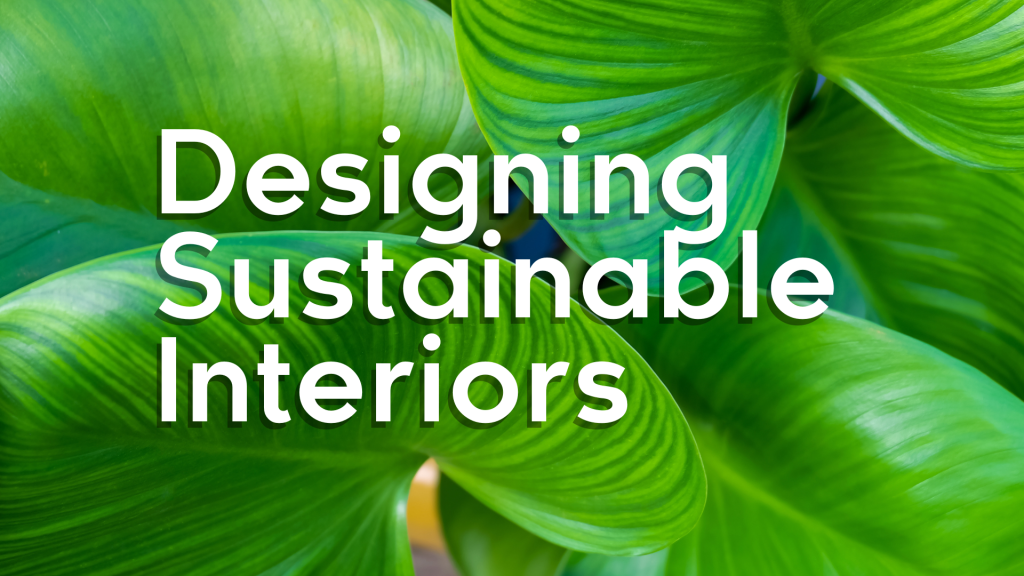3 Principles of Sustainable Interior Design
In the Interior Design world, buzzwords such as “eco-friendly,” “sustainable,” and “responsibly sourced” are frequently used. But what do these words refer to, and what constitutes a product as “responsibly sourced”? Allan Williams, LEED Green Associate, project director at SEA Studios, shares the basics of sustainable design. Our architects focus on three elements for sustainable interiors: reducing negative environmental impact and occupants’ health while improving building performance.
Reducing Environmental Impact in Sustainable Design
“Construction and demolition projects filled US landfills with almost 145 million tons of waste in 2018.”(EPA) To combat waste, the initial focus of the design is on conservation and recycling. This phase begins in the discovery and planning stages.
Touring the space, architects look for original architectural elements, furniture, and appliances that can be used “as is,” repurposed, or rehabilitated. For example, in the adaptive reuse project, (pictured) brick walls were uncovered during the initial discovery phase and became an integral part of the new design. In addition, the century-old steel beams were enhanced for additional structural support while paying homage to the original “industrial look.”

Other elements conserved were industrial tongue and groove wood flooring, existing doors and frames, hot and cold water piping, and mechanical ducts. The exposed ducts and piping at the roof structure were sanded, repaired, and freshly painted to create a cohesive look. The new design also reused desks and chairs (not pictured).
Most of the new materials in the design fell into one of three categories: recycled content, low VOC emissions, or responsibly sourced. Certifications to look for to reduce environmental impact are: “FSC© Certified,” “LEED points,” and “Cradle to Cradle.” When possible, the team sourced materials within a 500-mile radius. This project’s artwork is local to the region, lowering the carbon footprint.

Designing Healthy Environments
The health and well-being of the end users are a focal point of sustainable designs. An exceptional design creates a space where the occupants feel comfortable, happy, and productive. The three significant elements to achieving a healthy environment are air quality, lighting, and furniture.
Most commercial suppliers are committed to manufacturing sustainable products; it’s more accessible to a wide range of “green” materials. Plus, various certifications specify low emitting materials: “GreenGuard Gold,” “Green Label,” “Certified Indoor Air Quality,” and “Green Circle.”
In this project, the tables, chairs, wood veneers, wall coverings, wood slats, and floor tiles all have certifications for low VOCs in the breakroom. In addition, the wooden ceiling slats, paint, orange chairs, wood table, and carpet tiles have similar certifications in the reception area.
As for natural light, studies suggest employees have less eye strain and drowsiness, better moods, and are more productive when working in a naturally lit environment. Therefore, the goal of this project was to create an open space with an abundance of natural light. For example, opening up the reception area allows light from skylights and windows to flow through the space. In addition, replacing the old stairwell with glass and steel allows light to penetrate the floor below.
HealthLine.com states the benefits of an adjustable height desk can lower the risk of weight gain, blood sugar levels, and heart disease, reduce back pain, and has the potential to boost productivity. Standing desks (not pictured) are in some work areas, while ergonomic chairs are at all workstations to support posture and reduce neck pain.
Lastly, a gym/exercise facility (not pictured) is located on the lower floor for employee use and designated outdoor green space.

Lowering Energy Consumption
Improving the building’s envelope with any adaptive reuse or rehabilitation project is essential. Otherwise, energy-efficient equipment will work double duty, defeating the purpose of the savings. A few notable items are replaced and updated: the existing windows are now UV insulated fiberglass and high-grade insulation.
Lighting is the single largest source of electricity in commercial buildings. By replacing all fixtures with LED lighting, energy consumption will decrease. In addition, sensors are installed throughout the facility to ensure lights turn off when no movement occurs. The refrigerator in the breakroom and all appliances throughout the facility are Energy Star Certified.
As discussed in a previous article, Designing Net Zero Buildings, the end users need to be on board to lower energy consumption. The most impactful way of reducing a building’s energy load is by turning off appliances not in use, such as computers, coffee pots, printers, and personal electronics.

Designing Sustainable Interiors
Another trending area of sustainable interior design is creating biophilic spaces, incorporating nature indoors that contributes to the health and wellness of the occupants, for example, including trees, flowers, and plants in the design or adding a rooftop garden. In addition, nature-inspired wallcoverings, fountains, aquariums, or sculptures are good low-maintenance options.
There are many benefits for developers/owners of sustainably designed interiors and buildings; the two most significant are lowered operating costs and a command for higher rents. It has been challenging to find sustainable products to fit various budgets in the past. Today, our designers can design budget-minded to high-end projects that capture the “look” an owner desires using sustainable materials.
Have an office, office building, or retail space that needs an update? Let’s connect to discuss various options that can work.
Certifications:
- – LEED– a third-party green building certification program and the globally recognized standard for the design, construction, and operation of high-performance green buildings and neighborhoods.
- – Green Building Council– a non-profit organization that promotes sustainability in building design, construction, and operation.
- – Living Building Challenge focuses on the healing of people and the environment. The goal is to create Living Buildings that incorporate regenerative design solutions that actually improve the local environment rather than simply reducing harm.
- – Green Globes Building Certification- is an online assessment protocol, rating system, and guidance for green building design, operation, and management.
- – FSC© Certified– Forest Stewardship Council ensures products come from responsibly managed forests that provide environmental, social, and economic benefits. Three different certifications- 100% from well-managed forests, MIX- from responsible sources, and RECYCLED- made from recycled materials.
- – Cradle To Cradle Certification– attempts to measure the environmental and social sustainability of a product in five categories: material health, material re-utilization, renewable energy & carbon management, water stewardship, and social fairness.
- – Recycled Content Label– certifies the amount of post- and pre-consumer content in items such as home furniture.
- – Energy Star Label– products use less energy and help you save money on your electric bill.
- – WELL Certified Standard© – a performance-based system for measuring, certifying, and monitoring features of the built environment that impact human health and wellbeing, through air, water, nourishment, light, fitness, comfort, and mind.
- – FITWel Certification– the world’s leading certification system committed to building health for all®.
- – GreenGuard – certification provided by UL Environment, a division of UL (Underwriters Laboratories). They certify interior products and materials with low chemical emissions into indoor air during product usage.
- – Green Label Plus– an independent testing program that identifies carpet, adhesives, and cushion with very low emissions of VOCs to help improve indoor air quality.
- – Indoor Advantage Gold (Certified Indoor Air Quality)- assures that furniture products support a healthy indoor environment by meeting strict chemical emission limits for volatile organic compounds (VOCs).



